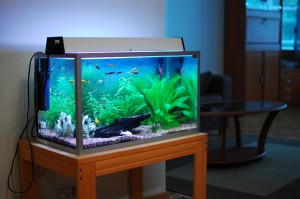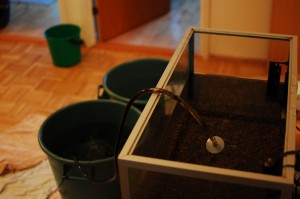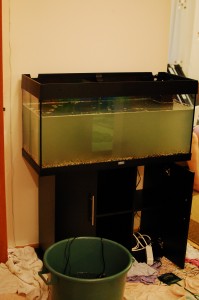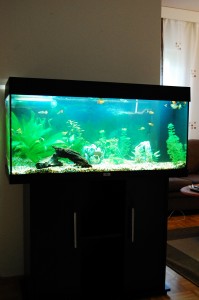For the past six years I had a 100 liters aquarium tank, which I would like to call an amateur tank. You know – it’s one of those kits they sell you at the local pet store with everything included and really one of those you normally may recall as a “normal” tank. Still, a 100 liters tank is big enough to really get excited and get enough plants and fish to appreciate this hobby. And it was a high quality tank made in Finland. So it was a great way to get started.  As you can see from the picture, there were quite a few plants which in my opinion did well. And the fish as well.
As you can see from the picture, there were quite a few plants which in my opinion did well. And the fish as well.
My primary principle for this hobby is that everything costs, and if you are about to take this seriously it’s worth spending an extra 10 euros or so to get the best items you can. As you can see from the picture, I had a bigger filter than required. It was graded for 120 liters to 150 liters. This kept the water clear and the water flow high enough. I also use Easy-life ProFito as plant fertilizer and Easy-Life Carbo for extra carbon.
At the time my wife and I wanted to get some more fish, but as the 100 liters tank can get quite crowded we faced the situation of not wanting to get any more fish. Either we didn’t take more fish – or got a bigger tank. So we went for the second alternative 🙂 The local aquarium store had a Juwel RIO 180 tank set with Bioflow filtering system included on sale. This was our opportunity and so we bought the set. So it took us the whole weekend to change the tanks – but I guess that’s what this hobby is about, so it was really nice in the end. But there were many steps to this.
 We had two 50 liters barrels. In one of them we put all the fish and plants into, together with the water from the aquarium. In the other one we simply put the old water into. It’s important to remember to put the heater and the filter in the barrel together with the fish and the plant. This operation will take long enough for the fish to start feel uncomfortable. This operation alone took a good hour to complete. Btw. it’s always interesting to see how filthy the bottom of your aquarium is although you think you got most of the filth out. Think of that when you are cleaning the bottom and you think you got most of it out.
We had two 50 liters barrels. In one of them we put all the fish and plants into, together with the water from the aquarium. In the other one we simply put the old water into. It’s important to remember to put the heater and the filter in the barrel together with the fish and the plant. This operation will take long enough for the fish to start feel uncomfortable. This operation alone took a good hour to complete. Btw. it’s always interesting to see how filthy the bottom of your aquarium is although you think you got most of the filth out. Think of that when you are cleaning the bottom and you think you got most of it out.
 After the old tank is empty and moved aside, it’s time to start working on the new tank. With the Juwel tank you need to first assemble the cabin which is included. Then you can start filling the tank with sand and water. However, here you can see the rookie mistake I made when we were switching the tanks. We were so eager to have the new, fine, tank in place that we totally forgot to wash out the new sand! 🙁 The water was all hazy. This turned out to be a big problem and a mistake I will never forget. We ended up changing the water twice and leaving the pump on for hours t o get the water clear, but it wasn’t very clear even the next morning. We used liquid bacteria solution to increase the maturity of the tank as fast as possibly. Anyway, we put the fish and plants in and to my great relief the fish didn’t mind too much. Apart from two. I am probably going to write about these more in the future, but we had two new beautiful Dwarf gourami fish in the new tank. We had to change water still a couple of times due to the hazy water. They are very sensitive fish and they couldn’t take the stress from the water changes and the new environment. This is very sad.
After the old tank is empty and moved aside, it’s time to start working on the new tank. With the Juwel tank you need to first assemble the cabin which is included. Then you can start filling the tank with sand and water. However, here you can see the rookie mistake I made when we were switching the tanks. We were so eager to have the new, fine, tank in place that we totally forgot to wash out the new sand! 🙁 The water was all hazy. This turned out to be a big problem and a mistake I will never forget. We ended up changing the water twice and leaving the pump on for hours t o get the water clear, but it wasn’t very clear even the next morning. We used liquid bacteria solution to increase the maturity of the tank as fast as possibly. Anyway, we put the fish and plants in and to my great relief the fish didn’t mind too much. Apart from two. I am probably going to write about these more in the future, but we had two new beautiful Dwarf gourami fish in the new tank. We had to change water still a couple of times due to the hazy water. They are very sensitive fish and they couldn’t take the stress from the water changes and the new environment. This is very sad.
 Today the Juwel RIO 180 aquarium looks like this. I personally think it looks nice, although I still want the plants to grow more.
Today the Juwel RIO 180 aquarium looks like this. I personally think it looks nice, although I still want the plants to grow more.
When comparing the old 100 liters tank with the new Juwel RIO 180 tank, I can say that this hobby is now on a next level. In a good way. The new tank feels so much better. First noticeable difference is of course the looks. It looks so much better. The cabin on which the tank stands is so practical and we keep all the food and plant fertilizers there together with other equipment. It’s so much more practical to have the items you need regularly close by but hidden.
The tank is closed, which means that the lights are inside the tank. This makes it look much more solid. Also the lights are much more efficient so I can only imagine that the plants like this much more.
The filtering system is just brilliant. First you notice how much more quite it is than the old separate one. The filtering system is also more efficient than the old one, although I had a larger filter system in my 100 liters tank than required. Also the maintainability of the filtering system is easy. It consists of seven different sponges on top of each other in this vertical space in the corner of the tank. The two top most are replaced most frequently (a fine filter for coarse filth and plant parts and the active carbon sponge for eliminating toxins) – once a week and once a month. The other sponges are there for different type of filtering, one for good bacterial growth and one for removing nitrate. I could never imagine this complex filtering system until I heard of Juwel Bioflow and I am really happy that my aquarium now has this. It makes so much more sense and I am sure this improves the water quality, but also eases the maintainability of the aquarium.
One thing I am not yet sure about is the frequency of the water changes. So far we have changed the water once a week or once every two weeks (due to other circumstances – other posts about those) or just to remove filth from the bottom. I need to check the water metrics to see what is the optimal change frequency. But I am sure it’s not as often as with the old 100 liters tank thanks to the larger capacity but also the Bioflow filtering system (hopefully it is already working).
2 Comments.